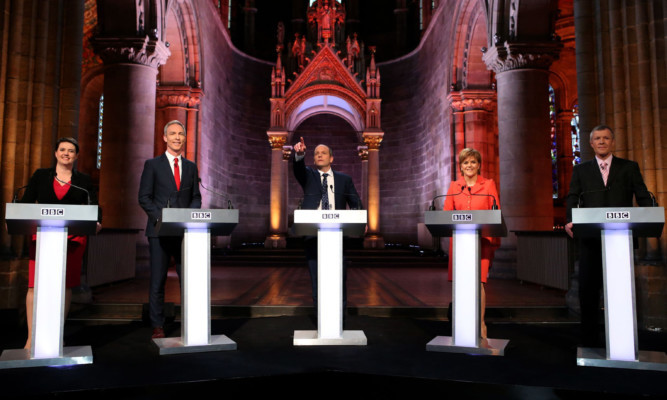It didn’t take long for things to go nuclear at the final Scottish leaders’ election TV debate.
Sometimes pondering whether our political leaders have anger management problems is not unreasonable.
Not surprisingly, independence was a trigger subject during the BBC head-to-head as Nicola Sturgeon refused to rule out the renewal of the UK’s Trident weapons system as the firing gun for a potential second referendum.
Scottish Labour leader Jim Murphy, never one to miss a soundbite to try to revive his party’s faltering election campaign, asked for a five-year moratorium on such a vote as the SNP leader got frustrated and told the audience it’s not her making it an election issue.
Rather depressingly, there was no calm and reasoned debating style.
There was a lot of shouting and interrupting as chairman Glenn Campbell had the unenviable task of trying to keep the politicians in check.
At least Lib Dem leader Willie Rennie managed to retain his composure as Sturgeon, Murphy and Scottish Conservative boss Ruth Davidson bellowed at, over and about one another. The Labour man got so animated he invented a new word, talking about things of “fundilymundily” importance.
Like the Institute for Fiscal Studies, for example, whose work on the SNP’s plans for full fiscal autonomy were called “mythology” by the First Minister.
Not because they put a big black hole in their fiscal plans, though. Obviously.
That happened after Davidson and Murphy accused each other of lying over benefits sanctions as voices soared above “indoor level” within 10 minutes.
We also had the slightly bizarre sight of the Tory leader supporting the current first past the post voting system, even though her party suffers in Scotland because of it, as Nicola Sturgeon outlined her opposition to it even as the SNP is about to benefit.
Rennie called it “pathetic” and “corrupt” but it’s unlikely any different way of tallying those crossed boxes could help the Lib Dems much.
What did we learn? Nothing new or concrete, except it’s noticed when our politicians go over the top.
Campbell’s final question to the audience was: “Did they behave OK?” It was the only time the echoey Mansfield Traquair in Edinburgh fell into stony silence, which probably says it all.
